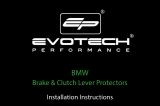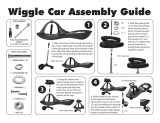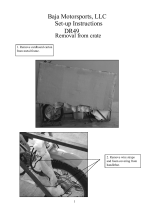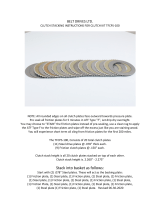Kawasaki KX450F 2012 Owner's manual
- Category
- Motorcycles
- Type
- Owner's manual



Quick Reference Guide
This Quick Reference Guide will assist you in
finding the information you're looking for.
A Table of Contents is included after the Foreword.
GENERAL INFORMATION
MAINTENANCE AND ADJUSTMENT
TROUBLESHOOTING GUIDE
TUNING
STORAGE

IMPORTANT INFORMATION
•
This vehicle is designed for the operator only, no passengers.
•
This vehicle is a competition model only and was not manufactured for use on public streets, roads or high-
ways.
•
The use of this vehicle should be limited to participation in sanctioned competition events upon a closed
course.
•
This vehicle should not be used for general off-road recreational riding.
•
Read owner's manual.

Whenever you see the symbols shown below,
heed their instructio ns! Always follow safe operating
and maintena nce practices.
DANGER
DANGER indicates a hazardous situation
which, if not avoided, will result in death or
serious injury.
WARNING
WARNING indicates a hazardous situation
which, if not avoided, could result in death or
serious injury.
NOTICE
NOTICE is used to address practices not re-
lated to personal injury.
NOTE
○
This note symbol indicates points of particular in-
terest for more efficient and convenient operation.
IMPORTANT NOTICE
THIS VEHICLE IS A COMPETITION MODEL ON-
LY AND WAS NOT MANUFACTURED FOR, NOR
SHOULD IT BE USED ON, PUBLIC STREETS,
ROADS, OR HIGHWAYS. THE USE OF THIS VE-
HICLE SHOULD BE LIMITED TO PARTICIPATION
IN SANCTIONED COMPETITION EVENTS UPON
A CLOSED COURSE. THIS VEHICLE SHOULD
NOT BE USED FOR GENERAL OFF-ROAD REC-
REATIONAL RIDING.
READ OWNER'S MANUAL.
WARNING
THIS VEHICLE SHOULD NOT BE USED FOR
GENERAL OFF-ROAD RECREATIONAL RID-
ING.
DISCLAIMER OF WARRANTY
This motorcycle is sold AS IS, with all faults,
obvious or concealed and there are NO WAR-
RANTIES, expressed or implied. Including war-
ranties of MERCHANTABILITY or FITNESS FOR
PURPOSE.
The purchaser accepts all responsibilities con-
cerning quality, performance, cost of service
and/or necessary repairs.

NOTICE
Off-road motorcycling is a wonderful sport, and
we hope you will enjoy it to the fullest. However,
if improperly conducted, this sport has the po-
tential to cause environmental problems as well
as conflicts with other people. Responsible use
of your off-road motorcycle will ensure that
these problems and conflicts do not occur. TO
PROTECT THE FUTURE OF YOUR SPORT,
MAKE SURE YOU USE YOUR MOTORCYCLE
LEGALLY, SHOW CONCERN FOR THE ENVI-
RONMENT, AND RESPECT THE RIGHTS OF
OTHER PEO PLE.

FOREWORD
Congratulations on your choosing this Kawasaki motorcycle. Your new motorcycle is the product of Kawasa-
ki's adv anced engineering, exhaustive testing, and continuous striving for a superior lightweight, high-perform-
ance machine with superb handling and stability for racing and sporting use.
Your new KX is a highly tuned competition machine for participation in racing events. As with any mechanical
device, proper care and maintenance are important for trouble-free operation and top performance. This man-
ual is written to enable you to keep your KX properly tuned and adjusted.
Due to improvements in design and performance made during production, in some cases there may be minor
discrepancies between the actual vehicle and the illustrations and text in this manual.
KAWASAKI HEAVY INDUSTRIES, LTD.
Motorcycle & Engine Company
© 2011 Kawasaki Heavy Industries, Ltd. Mar. 2011. (1).

TABLE OF CONTENTS
SPECIFICATIONS .............................................. 7
GENERAL INFORMATION ................................ 10
Location of Parts .............................................. 10
Side Stand ........................................................ 13
Fuel ................................................................... 13
Fuel Requirement: ......................................... 14
Kick Pedal ........................................................ 16
Starting the Engine ........................................... 16
Launch Control Mode ...................................... . 18
DFI Setting Data Selection ............................... 19
Shifting Gears ................................................... 20
Stopping the Motorcycle ................................... 21
Stopping the Engine ......................................... 21
Break-In ............................................................ 22
Daily Pre-Ride Checks ..................................... 23
After-Race Checks ........................................... 25
MAINTENANCE AND ADJUSTMENT ............... 26
Periodic Maintenance Chart ............................. 26
Engine Oil ......................................................... 31
Cooling System ................................................ 36
Spark Plug ........................................................ 39
Air Cleaner .............................. .......................... 46
Throttle Cable ................................................... 52
Throttle Body Assy ........................................... 53
Clutch .................... ........................................... 64
Valve Clearance ............................................... 74
Exhaust System ............................................... 80
Drive Chain ....................................................... 84
Adjustable Ergonomics .................................... 90
Footpeg ............................................................ 92
Brakes .............................................................. 94
Steering ............................................................ 98
Front Suspension .............................................101
Rear Suspension (UNI-TRAK®) ......................129
Wheels .................................................. ...........135
Hoses Inspection ..............................................138
Tightening Torques of Nuts and Bolts ..............139
Cleaning Your Motorcycle ................................143
Lubrication ........................................................145
DFI Self-Diagnosis ..........................................148
TROUBLESHOOTING GUIDE ...........................155
TUNING ..................................................... ..........162
Suspension .......................................................162
Gearing .............................................................168
Special Care According to Track Conditions ...169
OPTIONAL PARTS .............................................170
PRE-RACE CHECKS AND AFTER-RACE
MAINTENANCE ..............................................
172
STORAGE .......... .................................................174
Before Storage ................................................ .174
After Storage ....................................................175
ENVIRONMENTAL PROTECTION ....................176
WIRING DIAGRAM .............................................177

SPECIFICATIONS
DIMENSIONS
Overall Length 2 180 mm (85.83 in.)
Overall Width 820 mm (32.3 in.)
Overall Height 1 275 mm (50.20 in.)
Wheelbase 1 480 mm (58.27 in.)
Road Clearance 330 mm (13.0 in.)
Curb Mass 113 kg (249 lb)
Fuel Tank Capacity 6.2 L (1.6 US gal)
ENGINE
Type 4-stroke, DOHC, single-cylinder, liquid-cooled
Bore × Stroke 96.0 × 62.1 mm (3.78 × 2.44 in.)
Displacement 449 cm³ (27.4 cu in.)
Compression Ratio 12.5:1
Fuel System FI (Fuel Injection)
Starting System Primary kick
Ignition Sys tem Digital DC-CDI
Ignition Timing 10° BTDC @2 000 r/min (rpm)
Lubrication System Forced lubrication (semi-dry sump)
Spark Plug NGK CPR8EB-9
Spark Plug Terminal Solid-post
TRANSMISSION
Transmission Type 5-speed, return shift
SPECIFICATIONS 7

Clutch Type Wet, multi disc
Driving System Chain drive
Gear Ratio:
1st 1.750 (28/16)
2nd 1.412 (24/17)
3rd 1.188 (19/16)
4th 1.000 (19/19)
5th 0.875 (21/24)
Primary Reduction Ratio 2.727 (60/22)
Final Reduction Ratio 3.846 (50/13)
Overall Drive Ratio 9.178 @Top gear
Engine Oil:
Type
API SG, SH, SJ, SL or SM with JASO MA, MA1 or MA2
Viscosity SAE 10W-40
Capacity 1.2 L (1.3 US qt)
FRAME
Type Tubular, semi-double cradle
Steering Angle 42° to either side
Caster 26.9°
Trail 113 mm (4.45 in.)
Tire Size/Type:
Front 80/100-21 51M/BRIDGESTONE M403
Rear 120/80-19 63M/BRIDGESTONE M404
8 SPECIFICATI ONS

Rim Size:
Front 21 × 1.60
Rear 19 × 2.15
Suspension:
Front Telescopic fork (upside-down)
Rear New Uni-trak
®
swingarm
Front Suspension Travel 314 mm (12.4 in.)
Rear Wheel Travel 315 mm (12.4 in.)
Front Fork Oil:
Type KAYABA 01
Capacity (P er Fork Leg):
Inner Damper 198 mL (6.69 US oz.)
Inner/Outer Tubes 320 ~ 380 mL (10.8 ~ 12.8 US oz.)
BRAKES
Type:
Front Single disc
Rear Single disc
Specifications are subject to change without notice.
SPECIFICATIONS 9

GENERAL INFORMATION
Location of Parts
1. Clutch Lever
2. Engine Stop Button
3. Launch Control Mode Button
4. Orange Launch Control Mode/FI Indicator Light
5. Fuel Tank Cap
6. Front Brake Fluid Reservoir
7. Front Brake Lever
8. Throttle Grip
10 GENERAL INFORMATION

1. Front Fork
2. Radiator
3. Fuel Tank
4. Throttle Body Assy
5. Seat
6. Air Cleaner Element
7. Brake Disc
8. Brake Caliper
9. Shift Pedal
10. Footpeg
11. Rear Shock Absorber
12. Swingarm
13. Drive Chain
14. Chain Guide
GENERAL INFORMATION 11

1. Muffler
2. Rear Brake Fluid Reservoir
3. Rear Shock Absorber Gas Reservoir
4. Kick Pedal
5. DFI Setting Data Selection Connector
6. Uni-Trak
®
Tie-Rod and Rocker Arm
7. Rear Brake Pedal
8. Oil Level Gauge
9. Exhaust Pipe
12 GENERAL INFORMATION

Side Stand
To install the side stand , insert its flat end into the
rear axle as shown in the figure.
A. Side Stand
B. Rear Axle
WARNING
Riding with the side stand can cause a crash
resulting in injury. Do not start the engine or
attempt to ride the motorcycle when the side
stand is installed.
NOTE
○
Support the motorcycle with a suitable stand to
perform maintenance or adjustment procedures.
Fuel
This Kawasaki KX has a 4-stroke engine that re-
quires a gasoline.
The capacity of the fuel tank is 6.2 L (1.6 US gal).
To open the fuel tank cap, pull out the breather hose
from the hole in the steering stem, and turn the tank
cap counterclockwise.
A. Fuel Tank Cap
B. Breather Hose
GENERAL INFORMATION 13

WARNING
Gasoline is extremely flammable and can be
explosive under certain conditions. Always
stop the engine and do not smoke. Make sure
the area is well-ventilated and free from any
source of flame or sparks; this includes any
appliance with a pilot light. Never fill the tank
so the fuel level rises into the filler neck. If the
tank is overfilled, heat may cause the fuel to
expand and overflow through the vent s in the
tank cap. After refueling, make sure the fuel
tank cap is closed securely. If gasoline is
spilled on the fuel tank, wipe it off immedi-
ately.
Fuel Requir ement:
Fuel Type
Use clean, fresh unleaded gasoline with an Anti-
knock index equal to or higher than that shown in
the table. The Antiknock Index is posted on service
station pumps in Canada and the U.S.A. The octane
rating of a gasoline is a measure of its resistance to
detonation or “knocking”. The Antiknock Index is an
average of the Research Octane Num ber (RON)
and the Motor Octane Num ber (MON) as shown in
the table below.
Octane Rating Method
Minimum Rat-
ing
Antiknock Index
(RON + MON)
90
2
NOTICE
If engine “knocking” or “pinging” occurs, use
a different brand of gasoline of a higher oc-
tane rating.
If this condition is allowed to continue it can
lead to severe engine damage.
Gasoline quality is important. Fuels of low
quality or not meeting standard industry
specifications may result in unsatisfactory
performance. Operating problems that result
from the use of poor quality or nonrecom-
mended fuel may not be covered under your
warranty.
Fuels Containing Oxygenates
Gasoline frequently contains oxygenates (alco-
hols and ethers) especially in areas of Canada and
the U.S. which are required to sell such reformu-
lated fuels as part of a strategy to reduce ex haust
emissions.
The types and volume of fuel oxygenates ap-
proved for use in unleaded gasoline by the Cana-
dian Environmental Protection Agency include a
broad range of alcohols and ethers, but only two
components have seen any significant level of com-
mercial use.
Gasoline/Alcohol Blends - Gasoline containing up
to 10% ethanol (alcohol produced from agricultural
products such as corn), also known as “gasohol” is
approved for use.
14 GENERAL INFORMATION

NOTICE
Avoid using blends of unleaded gasoline and
methanol (wood alcohol) whenever possible,
and never use “gasohol” containing more
than 5% methanol. Fuel system damage and
performance problems may result.
Gasoline/Ether Blends - The most common ether
is methyl tertiary butyl ether (MTBE). You may use
gasoline contai ning up to 15% MTBE.
NOTE
○
Other oxygenates approved for use in unleaded
gasoline include TAME (up to 16.7%) and ETBE
(up to 17.2%). Fuel containing these oxygenates
can also be used in your Kawasaki.
NOTICE
Never use gasoline with an octane rating low-
er than the minimum specified by Kawasaki.
Never use “gasohol” with more than 10%
ethanol, or more than 5% methanol. Gasoline
containing methanol must also be blended
with cosolv ents and corrosion inhibitors.
Certain ingredients of gasoline may cause
paint fading or damage. Be extra careful not
to spill gasoline or gasoline oxygenate blends
during refueling.
When not operat ing your Kawasaki for 30 to
60 days, mix a fuel stabilizer (such as STA-
BIL) with the gasoline in the fuel tank. Fuel
stabilizer additives inhibit oxidation of the
fuel which minimizes gummy deposits.
Never store this product with “gasohol” in the
fuel system. Before storage it is recom-
mended that you drain all fuel from the fuel
system. See the Storage section in this man-
ual.
GENERAL INFORMATION 15

Kick Pedal
This motorcycle is equipped with a primary kick
starting system. When the clutch lever is pulled, the
motorcycle can be started with the transmission in
any gear.
A. Kick Pedal
Starting the Engine
•
Shift the transmission into neutral.
WARNING
Riding with the side stand can cause a crash
resulting in injury. Do not start the engine or
attempt to ride the motorcycle when the side
stand is installed.
NOTICE
This motorcycle is designed for competition
use only. Therefore, the radiator does not in-
corporate a coolant reserve tank or cooling
fan. Prolonged idling of the engine with no
airflow through the radiator can cause cool-
ant loss and engine overheating resulting in
possible engine damage. Any riding condi-
tions that increa se engine temperature will
further reduce idling time before coolant loss
occurs. Thes e conditions include high ambi-
ent temperature, sandy or muddy terrain, or
other conditions causing high engine loads at
low speeds. Furthermore, warming the engine
up excessively before operation, or leaving
idling with th e hot engine temperature after
operation results in the engine overheating,
too.
16 GENERAL INFORMATION

When engine is cold
•
Pull out the idle adjusting screw/choke knob.
A. Idle Adjusting Screw/Choke Knob
•
Find the kick pedal position around the top so that
the resistance to depress the kick pedal is fully felt
by pushing down the kick pedal slowly.
•
Kick the engine over, leaving the throttle closed.
NOTE
○
When the clutch lever is pulled, the motorcycle
can be started with the transmission in any gear.
•
Even after the engine has started, do not push
back immediately the idle adjusting screw/choke
knob until the engine is thoroughly warmed up.
When engine is already warm or restarts
•
Kick the engine over, leaving the throttle closed
without using the idle adjusting screw/choke
knob.
NOTE
○
If the engine fails starting, open the throttle fully
and depress the kick pedal slowly about 4 ~ 5
times to clear too rich fuel mixtures in the engine.
Then, kick the engine over, leaving the throttle
closed.
GENERAL INFORMATION 17

Launch Control Mode
The launch control mode can be used to adjust
ignition timing to help riders get better starts on slip-
pery terrain.
The system's effectiveness is dependent on rider
skill, technique and terrain conditions.
Launch Control Mode Setting
•
The launch control mode can be set when the en-
gine is running and in neutral, 1st or 2nd gear.
When activated, it only functions in 1st and 2nd
gear.
•
When pushing the launch control mode button for
over two seconds, the orange launch control
mode indicator light will blink to indicate the sys-
tem is operating.
•
When shifting into 3rd, the system is deactivated
automatically.
A. Launch Control Mode Button
B. Orange Launch Control Mode/FI Indicator Light
18 GENERAL INFORMATION
Page is loading ...
Page is loading ...
Page is loading ...
Page is loading ...
Page is loading ...
Page is loading ...
Page is loading ...
Page is loading ...
Page is loading ...
Page is loading ...
Page is loading ...
Page is loading ...
Page is loading ...
Page is loading ...
Page is loading ...
Page is loading ...
Page is loading ...
Page is loading ...
Page is loading ...
Page is loading ...
Page is loading ...
Page is loading ...
Page is loading ...
Page is loading ...
Page is loading ...
Page is loading ...
Page is loading ...
Page is loading ...
Page is loading ...
Page is loading ...
Page is loading ...
Page is loading ...
Page is loading ...
Page is loading ...
Page is loading ...
Page is loading ...
Page is loading ...
Page is loading ...
Page is loading ...
Page is loading ...
Page is loading ...
Page is loading ...
Page is loading ...
Page is loading ...
Page is loading ...
Page is loading ...
Page is loading ...
Page is loading ...
Page is loading ...
Page is loading ...
Page is loading ...
Page is loading ...
Page is loading ...
Page is loading ...
Page is loading ...
Page is loading ...
Page is loading ...
Page is loading ...
Page is loading ...
Page is loading ...
Page is loading ...
Page is loading ...
Page is loading ...
Page is loading ...
Page is loading ...
Page is loading ...
Page is loading ...
Page is loading ...
Page is loading ...
Page is loading ...
Page is loading ...
Page is loading ...
Page is loading ...
Page is loading ...
Page is loading ...
Page is loading ...
Page is loading ...
Page is loading ...
Page is loading ...
Page is loading ...
Page is loading ...
Page is loading ...
Page is loading ...
Page is loading ...
Page is loading ...
Page is loading ...
Page is loading ...
Page is loading ...
Page is loading ...
Page is loading ...
Page is loading ...
Page is loading ...
Page is loading ...
Page is loading ...
Page is loading ...
Page is loading ...
Page is loading ...
Page is loading ...
Page is loading ...
Page is loading ...
Page is loading ...
Page is loading ...
Page is loading ...
Page is loading ...
Page is loading ...
Page is loading ...
Page is loading ...
Page is loading ...
Page is loading ...
Page is loading ...
Page is loading ...
Page is loading ...
Page is loading ...
Page is loading ...
Page is loading ...
Page is loading ...
Page is loading ...
Page is loading ...
Page is loading ...
Page is loading ...
Page is loading ...
Page is loading ...
Page is loading ...
Page is loading ...
Page is loading ...
Page is loading ...
Page is loading ...
Page is loading ...
Page is loading ...
Page is loading ...
Page is loading ...
Page is loading ...
Page is loading ...
Page is loading ...
Page is loading ...
Page is loading ...
Page is loading ...
Page is loading ...
Page is loading ...
Page is loading ...
Page is loading ...
Page is loading ...
Page is loading ...
Page is loading ...
Page is loading ...
Page is loading ...
Page is loading ...
Page is loading ...
Page is loading ...
Page is loading ...
Page is loading ...
Page is loading ...
Page is loading ...
Page is loading ...
Page is loading ...
Page is loading ...
Page is loading ...
Page is loading ...
Page is loading ...
Page is loading ...
-
 1
1
-
 2
2
-
 3
3
-
 4
4
-
 5
5
-
 6
6
-
 7
7
-
 8
8
-
 9
9
-
 10
10
-
 11
11
-
 12
12
-
 13
13
-
 14
14
-
 15
15
-
 16
16
-
 17
17
-
 18
18
-
 19
19
-
 20
20
-
 21
21
-
 22
22
-
 23
23
-
 24
24
-
 25
25
-
 26
26
-
 27
27
-
 28
28
-
 29
29
-
 30
30
-
 31
31
-
 32
32
-
 33
33
-
 34
34
-
 35
35
-
 36
36
-
 37
37
-
 38
38
-
 39
39
-
 40
40
-
 41
41
-
 42
42
-
 43
43
-
 44
44
-
 45
45
-
 46
46
-
 47
47
-
 48
48
-
 49
49
-
 50
50
-
 51
51
-
 52
52
-
 53
53
-
 54
54
-
 55
55
-
 56
56
-
 57
57
-
 58
58
-
 59
59
-
 60
60
-
 61
61
-
 62
62
-
 63
63
-
 64
64
-
 65
65
-
 66
66
-
 67
67
-
 68
68
-
 69
69
-
 70
70
-
 71
71
-
 72
72
-
 73
73
-
 74
74
-
 75
75
-
 76
76
-
 77
77
-
 78
78
-
 79
79
-
 80
80
-
 81
81
-
 82
82
-
 83
83
-
 84
84
-
 85
85
-
 86
86
-
 87
87
-
 88
88
-
 89
89
-
 90
90
-
 91
91
-
 92
92
-
 93
93
-
 94
94
-
 95
95
-
 96
96
-
 97
97
-
 98
98
-
 99
99
-
 100
100
-
 101
101
-
 102
102
-
 103
103
-
 104
104
-
 105
105
-
 106
106
-
 107
107
-
 108
108
-
 109
109
-
 110
110
-
 111
111
-
 112
112
-
 113
113
-
 114
114
-
 115
115
-
 116
116
-
 117
117
-
 118
118
-
 119
119
-
 120
120
-
 121
121
-
 122
122
-
 123
123
-
 124
124
-
 125
125
-
 126
126
-
 127
127
-
 128
128
-
 129
129
-
 130
130
-
 131
131
-
 132
132
-
 133
133
-
 134
134
-
 135
135
-
 136
136
-
 137
137
-
 138
138
-
 139
139
-
 140
140
-
 141
141
-
 142
142
-
 143
143
-
 144
144
-
 145
145
-
 146
146
-
 147
147
-
 148
148
-
 149
149
-
 150
150
-
 151
151
-
 152
152
-
 153
153
-
 154
154
-
 155
155
-
 156
156
-
 157
157
-
 158
158
-
 159
159
-
 160
160
-
 161
161
-
 162
162
-
 163
163
-
 164
164
-
 165
165
-
 166
166
-
 167
167
-
 168
168
-
 169
169
-
 170
170
-
 171
171
-
 172
172
-
 173
173
-
 174
174
-
 175
175
-
 176
176
-
 177
177
-
 178
178
-
 179
179
-
 180
180
Kawasaki KX450F 2012 Owner's manual
- Category
- Motorcycles
- Type
- Owner's manual
Ask a question and I''ll find the answer in the document
Finding information in a document is now easier with AI
Related papers
-
Kawasaki KX450F - User manual
-
Kawasaki KX250F - User manual
-
Kawasaki KX450F 2013 Owner's manual
-
Kawasaki KX250F - User manual
-
Kawasaki KX250F - Owner's manual
-
Kawasaki KXF 450 Owner's manual
-
Kawasaki KLE500 User manual
-
Kawasaki KLE500 User manual
-
Kawasaki KX250F 2009 Owner's manual
-
Kawasaki KX450F - User manual
Other documents
-
 EVOTECH BMW User manual
EVOTECH BMW User manual
-
 Lil Rider 80-1288HP Operating instructions
Lil Rider 80-1288HP Operating instructions
-
Baotian BT49QT-3 User manual
-
Suzuki RM85 Owner's Service Manual
-
 Baja motorsports DR49 Assembly Instructions
Baja motorsports DR49 Assembly Instructions
-
FALCON RIDGE Oreion Reeper Black User manual
-
Suzuki DL1000AL4 Owner's manual
-
Black Widow BW-10-V2 User guide
-
 Belt Drives TFCPS-100 Installation guide
Belt Drives TFCPS-100 Installation guide
-
Toro Differential Replacement Kit, 725 Rear Engine Rider Installation guide























































































































































































